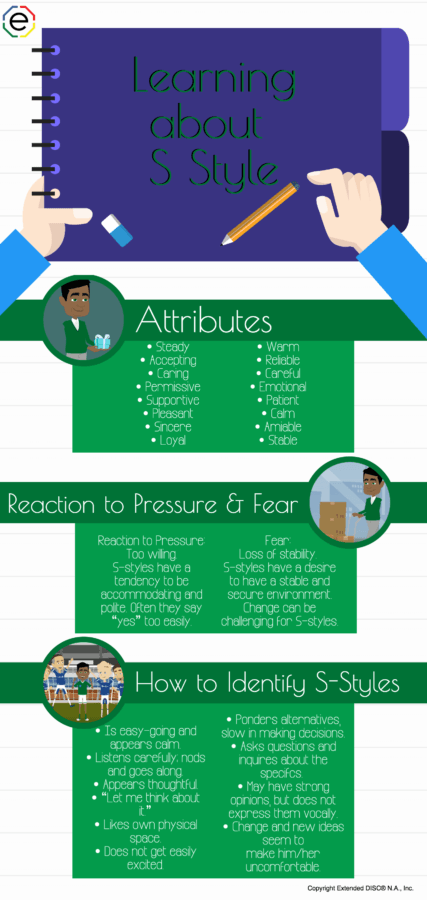The S-style profile type, also identified as the S-style personality type, is known for steadiness, security, and stability. Your DISC test identifies your primary DISC type.
The S-style profile type is one of the 4 DISC profile types including D-style, I-style and C-style profiles. S-styles make up 31% of the world population. The DISC types come from the William Marston’s DISC Model.
When understanding any of the 4 DISC types, keep the following important points in mind. There is no DISC profile that is better or worse. All DISC styles have strengths and development areas; they just happen to be different. A person’s DISC style does not limit what can be accomplished or how successful one can be. It simply predicts how we tend to do things.
We can find all of the four DISC types represented by very successful people. However, the most successful people know who they are. They modify their style appropriately with different styles of people and in different situations.
Describing the S-style Profile Type
S-style profiles are steady, calm and easy-going. They prefer interacting with people they know, since they are more reserved. S-style profiles prefer things to remain the same because they like stability and security. They view family and friends as very important. They will strongly defend their own group or team, sometimes emotionally. S-styles value fairness and justice.
S-styles are reliable and stable. They focus on cooperation, especially with the person in charge, to carry out the tasks. They want you to tell them what, when and how you want it done and they’ll be glad to do it. If you do not give an S-styles enough details, they may not get started because they don’t want to make mistakes. S-styles are more hesitant in their actions and decision-making. They want to consider others and focus on agreements.
Since S-styles prefer stability and security, they tend to resist change and need support with it. Their motto is “if it’s not broken, let’s not fix it.” When S-style profiles are under pressure they can become too accommodating. They will often say “yes” too easily. Their biggest fear is loss of stability. S-styles want a stable and secure environment. Change can be challenging for S-styles.
S-styles like to ask the “how” questions, “How are we going to do this?” or “How does this impact us?”
How to identify the S-style profile type
Here are some quick and simple ways to identify the S-style profile type:
- Is easy-going and appears calm.
- Listens carefully; nods and goes along.
- Appears thoughtful.
- Let me think about it.
- Likes own physical space.
- Does not get easily excited.
- Ponders alternatives, slow in making decisions.
- Asks questions and inquires about the specifics.
- Seems to have strong opinions but does not express them vocally.
- Completely new ideas/things seem to make him/her uncomfortable.

S-style profile attributes
Attributes are the words people use to describe the behavioral style of the s-style profile. It is not always how the person himself/herself would use to describe his/her own behavior. In addition, one certainly can adapt from one’s natural DISC style to different situations and roles.
- Steady
- Accepting
- Caring
- Permissive
- Supportive
- Pleasant
- Sincere
- Loyal
- Warm
- Reliable
- Careful
- Emotional
- Patient
- Calm
- Amiable
- Stable
S-style profile’s communication style
The S-styles, like the D-styles also prefer one directional communication. However, they prefer interactions in one-on-one settings. They answer when asked, but otherwise, they prefer listening to speaking. S-profiles tend to speak calmly and amiably. S-profiles look to create trust during the interaction. They prefer to talk about topics that they have mastered. In addition, they will explain things calmly and thoroughly.
Leadership style of the S-style profile type
The S-style profile’s authority is based on experience, expertise and organizational status. They are comfortable, as leaders, in maintaining routines and stability. They are service- orientated. The S-style prefers to lead smaller teams. Their leadership style is participative.

Examples of famous S-styles personality types
Using examples of people we know, famous or otherwise, helps us to quickly identify DISC styles.
- Mandy Moore
- David Beckham
- Bobby Ewing of Dallas
- Mahatma Gandhi
- Mr. Sulu of Star Trek
- Princess Kate – Duchess of Cambridge
- Michael J. Fox
- Halle Berry
- Matthew Broderick
- Tom Brokaw
- Peyton Manning
- Jimmy Fallon
- Rajesh of Big Bang Theory
From our blog: Steady Personality Type: Assert Your Strengths!
What about the other DISC styles?



